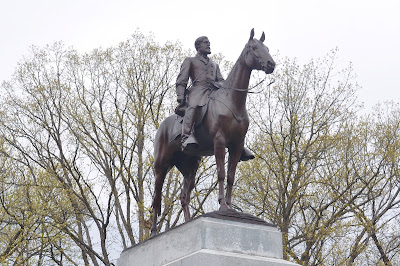No one knows for sure the exact date in the Fall of 1621 when the newly arrived colonists from England sat with and shared an autumn meal with the Wampanoag Indians in their settlement of Plymouth. That shared, community meal would become known as America's first Thanksgiving Day. Over the following years a few presidents would decree and a few states would hold a random Day of Thanksgiving but it would be 242 years after that first Plymouth gathering before the Thanksgiving Day we know and love today would become an annual, American celebration.
It took the fortunes of a terrible civil war, a spunky lady editor who lobbied and pushed the idea of a national day of thanksgiving through the pages of the American Ladies’ Magazine and a beleaguered, war-wary president all coming together in the fall of 1863 to start this great American tradition.
September 1863 began with the forces of the Union Army having completed a summer of great, battlefield victories. The most important of those victories occurred on July 1, 2 and 3 around the small farming community of Gettysburg, Pennsylvania. After three days of fighting, best estimates showed that the Union Army and Robert E. Lee’s Army of Virginia suffered together between 45,000 – 51,000 casualties.
Those casualty numbers included 3,155 Union soldiers and an estimated 4,708 Confederate soldiers killed in action. An estimated 1/3 of the Army of Virginia had been wounded, killed or were unaccounted for. Had Lee’s army prevailed at Gettysburg, they would have swept into Washington, DC and overrun the Union capitol. But with the victory at Gettysburg, the Union still stood and Gettysburg would prove to be the turning point of that terrible American war.
September 1863 found President Abraham Lincoln preparing to speak at the soon to be dedicated National Cemetery at Gettysburg. Since the beginning of his presidency in 1860, Sarah Josepha Hale, an influential magazine editor and the author of the nursery rhyme “Mary Had a Little Lamb” had been lobbying President Lincoln to declare an annual national day of thanksgiving.
On September 28. 1863 Ms. Hale once again wrote the president urging him to declare that the “day of our annual Thanksgiving made a National and fixed Union Festival." This time, after the events of the summer of 1863 and the Union Army’s victory at Gettysburg, President Lincoln agreed with Sarah Hall.
On October 3, 1863, Abraham Lincoln, President of the United States of America, issued a Proclamation of Thanksgiving to his fellow citizens in every part of the United States “to set apart and observe the last Thursday of November next, as a day of Thanksgiving and Praise to our beneficent Father who dwelleth in the Heavens.”
Lincoln soon traveled to Gettysburg, Pennsylvania on November 19, 1863 and delivered what could arguably be the greatest 263-word speech in the history of mankind – the Gettysburg Address. One week later, on November 26, 1863, on the fourth Thursday of November, President Lincoln, Sarah Hale and the American people across the Union celebrated Thanksgiving Day.
Since November 1863 Americans have paused every year to celebrate Thanksgiving Day on the fourth Thursday of November with the exception of 1939 when President Franklin D. Roosevelt changed the celebration to the third Thursday of November to lengthen the depression era Christmas holiday shopping season. The American people did not like this change and by 1941 President Roosevelt reluctantly signed a congressional bill reestablishing forever more the celebration of Thanksgiving on the fourth Thursday of November.
So as you gather with those that you love this Thanksgiving Day to pause in thanks, remember all those who have come before us to make this day such a special American holiday. It was the colonists of Plymouth and Wampanoag Indians that first gathered, but it was the unrelenting efforts of Sarah Josepha Hale and the proclamation of Abraham Lincoln that engenders us each and ever fourth Thursday of November to celebrate America’s Thanksgiving Day.
Here are some links for more information about the establishment of Thanksgiving Day…
Lincoln’s Proclamation of Thanksgiving - http://www.abrahamlincolnonline.org/lincoln/speeches/thanks.htm
Sarah Josepha Hale - http://www.pilgrimhallmuseum.org/pdf/Godmother_of_Thanksgiving.pdf
Sarah Hale’s letter to President Lincoln - http://womenshistory.about.com/od/thanksgiving/a/sarah_hale_letter.htm
Lincoln’s Gettysburg Address - http://history1800s.about.com/od/abrahamlincoln/a/gettysburgadd01.htm
You Tube video – Lincoln’s Proclamation of Thanksgiving - http://www.youtube.com/watch?v=9nU8yOHQKhQ
 |
| Abraham Lincoln |
 |
| Sarah Josepha Hale |
 |
| Monument to General George Meade, Commander of Union forces |
 |
| Monument to General Robert E. Lee, Commander of the Army of Virginia |
 |
| View of Little Round Top - battle July 2, 1863 |
 |
| View from Union stone wall across field from which came Pickett's Charge - July 3, 1863 |
 |
| Monument marking the "High Water Mark" of the rebel charge - July 3, 1863 |
 |
| "The Angle" and "Witness Tree" along the stone wall where Union forces repelled Pickett's Charge - July 3, 1863 |
 |
| Site where NPS marks location of Lincoln's Gettysburg Address. Historians say that Lincoln actually spoke down a small hill about 100 feet from this designated spot - November 19, 1863 |
 |
| Giving at the dedication of the Union Cemetery at the Gettysburg battlefield on November 19, 1863 |
 |
| View down the barrel of a Union cannon that roared with canisters and balls against rebel forces on July 1, 2 & 3, 1863 |

That’s an interesting thanksgiving day party. I am just so impressed with the details. Even I am going to host a grand party for Thanking my parents who have been by my side in all my ups and downs. It would be a weekend party and will prefer booking the best event halls for rent for this family bash. Can’t wait to see how it is going to be turned out.
ReplyDelete